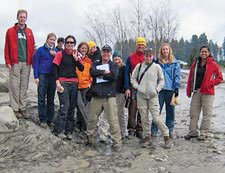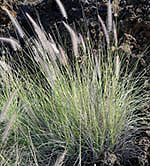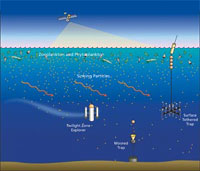Research News
- PHYSICAL WORLD: Mudflow witnessed | Meteorite evidence | Marine snow
- PSYCHOLOGY: Winning image
- HEALTH: Hepatitis plague | Fish fact | Vegetable servings | Tomato benefits | Soy studies
- ENVIRONMENT: Biofuels explored | Super-genotype found | Katrina aftermath
- OTHER: Scientists honored | Funding doubles
Scientists on hand for volcanic mudflow

On Christmas Eve 1953, a sudden mudflow on New Zealand’s Mount Ruapehu destroyed Tangiwai Bridge. Minutes later, an oncoming train plunged into the turbulent deluge and 151 people died.
During spring break 2007, another flow plowed down the same mountain. UH graduate students arrived a day later. Their observations contributed to an ongoing study that could help save countless lives and future tragedies.
Lahars are volcanic mudflows composed of water, pyroclastic material and other sediment triggered by rapidly melting snow or glaciers or the breakout of a volcanic lake. Traveling with great speed and mass, they cause catastrophic destruction along their path, often down a river valley.
Volcanoes where lahars are a threat include Mount Rainier in Washington state and Galunggung in Indonesia.
The March 18 breakout from Ruapehu’s Crater Lake was long predicted but earlier than expected. In anticipation, New Zealand scientists had installed an unprecedented number of instruments in the lahar’s pathway. Mānoa volcanologists Sarah Fagents and Bruce Houghton had joined their New Zealand colleages in a pre-event assessment of the channel conditions justdays before intense rain and increased seepage caused the lake bank to collapse, sending millions of gallons of water tearing down the valley.
The next day, they were back with the students to examine the broad devastated area, now covered in a veneer of mud and boulders. Their observations, together with data from the New Zealand instrumentation, will be used to test Fagents’ computer simulations of lahar development and flow.
"Our intent is to adapt this model to account for different lahar triggering mechanisms and for different locations to make it more widely applicable," says Fagents. The goal is to provide a hazard assessment tool for future lahars in populated areas.
Read the School of Ocean and Earth Science and Technology news release.
topIron meteorites shed light on early planet formation
New information about iron meteorites suggests planetary embryos formed within 1 million years after the birth of the solar system. Collisions between these protoplanets beginning 4.5 billion years ago created the rocky planets.
University of Hawaiʻi at Mānoa Planetary Scientist Edward Scott and colleagues from the University of Massachusetts, Amherst, believe many iron meteorites were created when protoplanets with still molten cores broke apart in glancing collisions early in solar system history.
Previous theories held that these meteorites cooled in smaller asteroids that collided and broke up much later. New studies showing that iron meteorites from the same source cooled at diverse rates suggest that the rocky silicate mantles were lost prior to cooling.
Writing in the April 19, 2007 issue of Nature, the scientists propose that iron meteorites came from protoplanets and predate formation of the unmelted meteorites called chondrites, thus providing evidence that protoplanets were abundant in the early asteroid belt.
For more information on iron meteorite, read SOEST’s PSR Discoveries or the Nature article.
topMarine snow stalls in the twilight zone
An ocean region known as the twilight zone lies 100–1,000 meter below the surface, where it receives some light, but not enough to sustain photosynthesis.
This zone acts as a gate, controlling the extent to which atmospheric carbon dioxide reaches the deep ocean. Carbon dioxide taken up by marine plankton at the ocean surface sinks into the region as marine snow, particles of dead or excreted organic matter that provide food for deep-dwelling species.
Scientists thought this sinking process might provide a storage mechanism for excess greenhouse gas, but a National Science Foundation–funded project called VERTIGO, for Vertical Transport in the Global Ocean, has found that carbon dioxide is sometimes consumed by animals within the twilight zone and returned to the atmosphere.
In the cover article of the April 27, 2007 issue of Science, the VERTIGO team, which includes Mānoa Professors Robert Bidigare and David Karl, reports that only half the carbon at the surface near Japan and a mere fifth off Hawaiʻi made it through the twilight zone.
The team plans further cruises to explore the regional differences and better understand the twilight zone and the role it might play in climate change.
For more information, read the April 26 news release or the Science article abstract.
topFaculty find kiʻi to athletic training

Illustration by Kelly Hironaka
A training regime based on a spiritual hula concept called kiʻi could help athletes be more successful when shooting a three-pointer or driving a long one down the fairway.
The word "kiʻi" has several meanings in the Hawaiian language, including an image, to summon or something used in a ritual. Combined, kiʻi becomes "an image used in ritual to fetch," say Harald Barkhoff, a sports psychologist and University of Hawaiʻ at Hilo associate professor of health and physical education, and Taupouri Tangaro, Hawaiian lifestyles assistant professor at Hawaiʻi Community College.
When athletes develop a "sacred image" of hitting a home run or finishing a marathon, their performance enters a deeper, spiritual, level that can provide the motivation needed to capture the prize.
Athletes must retain both a physical and psychological image of themselves being successful; this combination of real and envisioned is where kiʻi comes into play, the researchers told colleagues at the Popular Culture Association and Modern Culture Association International Conference in Iceland during the summer.
topEgypt addresses modern hepatitis plague
Egypt has the world’s highest prevalence rates of hepatitis C, with up to 18 percent of the population in rural areas infected. Traced to a mass injection treatment campaign to counter a blood-borne parasite in decades past, the infectious disease causes liver damage.
The hepatitis C virus presents a challenge comparable to HIV for its high replication and mutation rate, F. DeWolfe Miller, a University of Hawaiʻi at Mānoa public health professor, told colleagues at the annual American University in Cairo Research Conference in April 2007.
Miller co-discovered the epidemic in the early 1980s. He commended Egyptian health officials for steps taken since to make vaccines and blood transfusions safer and for a public health campaign aimed at reducing prevalence below 5 percent.
topFish-eaters, not fish diet linked to health
There is a lack of data to support the popular notion that eating fish, with its highly touted omega-3 fatty acids, is beneficial in and of itself.
In the May 1, 2007 issue of the American Journal of Cardiology, University of Hawaiʻi at Mānoa Associate Professor of Public Health Sciences Claudio Nigg and mainland colleagues report that fish eaters tend to be healthier because they also consume more fruits, vegetables and lentils and less red meat than non-fish-eaters.
For more information, read the article.
topWhat’s in a serving? Here’s how to count your vegetables

University of Hawaiʻi at Mānoa College of Tropical Agriculture and Human Resources nutrition educator Carissa Poon is Hawaiʻi coordinator for the national "Fruits and Veggies: More Matters" campaign.
The new campaign doesn’t specify an amount, but if you want to keep count, Poon offers this quick rundown on what constitutes a serving:
- 1 cup chopped lettuce (about 4 medium romaine leaves)
- 1/2 cup raw, frozen, canned or cooked fruit or vegetables (1/4 cup cooked for things like spinach that reduce considerably)
- 1/4 cup dried fruit or vegetables
- 25 raisins, 6 baby carrots, 4 large strawberries or 1 small orange
- 1/2 cup pure fruit juice
Cook tomatoes for superior cancer-prevention benefit
Cook your tomatoes in olive oil for maximum anti-cancer benefits, suggests Cancer Research Center of Hawaiʻi Researcher John Bertram.
The oil helps dissolve lycopene, the red pigment in tomatoes and watermelon, and increases its absorption by the body.
Lycopene in processed foods such as tomato extract, canned tomatoes and catsup is also more efficiently absorbed than that in raw tomatoes, boosting the effectiveness of these foods, particularly in protecting against prostate cancer.
topStudy examines soy link in cancer prevention
Cancer Reseearch Center of Hawaiʻi researchers would like to know if Asian men’s high intake of soy is related to their low incidence of prostate cancer.
A three-month pilot study of men consuming high- or low-soy diets suggests that the high-soy diet reduces serum prostate-specific antigen levels without affecting testosterone.
The results suggest further study is warranted, Researcher Gertraud Maskarinec and her team report in the June 14, 2006 issue of European Journal of Clinical Nutrition.
topPlants and plant-like bacteria produce fuel
Using a process akin to photosynthesis, a University of Hawaiʻi at Mānoa researcher is producing ethanol fuel from cyanobacteria, the scummy pond organism once thought to be blue-green algae.
In Assistant Professor of Molecular Bioscience and Bioengineering Pengcheng Fu’s patented photobioreactor process, genetically modified cyanobacteria use sunlight to convert carbon dioxide into ethanol. The process doesn’t require the time or energy input needed to grow crops such as corn or sugarcane for conversion to fuel.
Intent on building a full scale ethanol plant, Fu continues to seek more effective species of the chlorophyll-containing bacteria. He is also working with NASA on the organism’s potential as a fuel producer in space colonies on the moon or Mars.
Meanwhile, College of Tropical Agriculture and Human Resources colleagues are exploring plants that could be a source for biodiesel production.
Working with a colleague at the University of Guam, soil scientists Goro Uehara, Robert Paull and Richard Ogoshi are studying Jatropha curcas, or white physic nut, a leafy, fast growing, drought resistant tree that grows well on marginal lands.
They hope to identify a high yielding, nontoxic Jatropha species whose seeds could be used as animal feed once the oil is extracted. The project is funded by the Agricultural Development in the American Pacific project.
topFountain grass is an unexpected super-genotype

Samples of the highly invasive fountain grass are genetically uniform, whether taken from its native Egypt or more recent ranges in Africa and Hawaiʻi.
Typically, species experience genetic change as they adapt to the local conditions of different environments. But Pennisetum setaceum appears to be a super-genotype, pre-adapted to thrive under a broad range of ecological conditions.
Scientists call this phenomenon "plasticity," and it is significant both in refining our understanding of evolutionary process and in efforts to counter invasive species.
The findings were reported by a College of Tropical Agriculture and Human Resources team headed by Ania Wieczorek and published in the July 4, 2007, issue of Public Library of Science ONE.
For more information, read the article or view a video (Windows Media link).
topPost-Katrina water quality back to normal
The sewage-tainted floodwaters pumped into Lake Pontchartrain after Hurricane Katrina struck New Orleans caused only limited and short-lived degradation of water quality in the lake.
Researchers from the University of Hawaiʻi at Mānoa’s federally funded Pacific Research Center for Marine Biomedicine and their mainland colleagues reported results of water quality monitoring in the May 8, 2007, issue of the Proceedings of the National Academy of Sciences.
The warm brackish lake water that flooded the city in September 2005 was an ideal breeding ground for pathogenic species of Vibrio bacteria and may have contributed to increasing Vibrio infections and deaths reported to the U.S. Centers for Disease Control and Prevention.
But concentrations of Vibrio and Legionella bacteria dropped within two months as water temperatures fell below 50 degrees. Sewage contamination was no longer detectable in near-shore waters after several months, but continued presence of fecal indicator bacteria in canals and even non-flooded areas suggests sewage contamination in city soils and drainage water that warrants epidemiologic studies, says Assistant Professor of Oceanography Grieg Steward.
For details on the results, read the PNAS article. More about UH’s response to disasters including Hurricane Katrina in an earlier Mālamalama article.
topUniversity of Hawaiʻi scientists honored
Two University of Hawaiʻi at Mānoa researchers have been honored for groundbreaking research.
Emeritus Professor of Oceanography Klaus Wyrtki, who helped identify the ocean-weather link in the El Niño phenomenon (Mālamalama winter 1998), was elected a fellow of the American Academy of Arts and Sciences.
Astronomer John Tonry shares in the $500,000 Gruber Cosmology Prize as a member of one of two winning teams. Tonry’s observation of crucial supernovae explosions in distant galaxies contributed to the discovery that expansion of the universe is accelerating and unending.
topGrant funding doubles over five years
Hawaiʻi lead the nation in growth of federally funded research during the first part of the decade—doubling from $81 million in 2000 to $169 million in 2004, according to a new National Science Foundation report.
Another NSF study ranked Hawaiʻi second in growth in private industry research, nearly doubling to $21 million during the same period.
UH officials note that many grants address local issues, including these recent awards:
- $11.5 million for a five-year cardiovascular disease project
- $3.3 million from Japanese and U.S. agencies to study Pacific climate variability
- $450,000 to create a chamber to evaluate the impact of windblown debris on safe rooms and structural components
- $449,000 to assess the chronic effects of discharge of treated sewage on marine communities and sediments
- $398,000 to evaluate the effectiveness of restricted fishing areas in the main Hawaiian islands
